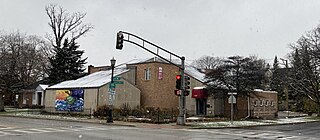
Beadwork is the art or craft of attaching beads to one another by stringing them onto a thread or thin wire with a sewing or beading needle or sewing them to cloth. Beads are produced in a diverse range of materials, shapes, and sizes, and vary by the kind of art produced. Most often, beadwork is a form of personal adornment, but it also commonly makes up other artworks.

The Mitchell Museum of the American Indian is a museum in Evanston, Illinois that focuses exclusively on the history, culture and arts of North American native peoples. It is a Core Member of the Chicago Cultural Alliance, a consortium of 25 ethnic museums and cultural centres in Chicago.

The Institute of American Indian Arts (IAIA) is a public tribal land-grant college in Santa Fe, New Mexico, United States. The college focuses on Native American art. It operates the Museum of Contemporary Native Arts (MoCNA), which is housed in the historic Santa Fe Federal Building, a landmark Pueblo Revival building listed on the National Register of Historic Places as Federal Building. The museum houses the National Collection of Contemporary Indian Art, with more than 7,000 items.

The visual arts of the Indigenous peoples of the Americas encompasses the visual artistic practices of the Indigenous peoples of the Americas from ancient times to the present. These include works from South America and North America, which includes Central America and Greenland. The Siberian Yupiit, who have great cultural overlap with Native Alaskan Yupiit, are also included.

Martha Berry is a Cherokee beadwork artist, who has been highly influential in reviving traditional Cherokee and Southeastern beadwork, particularly techniques from the pre-Removal period. She has been recognized as a Cherokee National Treasure and is the recipient of the Seven Star Award and the Tradition Bearer Award. Her work is shown in museums around the United States.

Linda Lomahaftewa is a Hopi and Choctaw printmaker, painter, and educator living in Santa Fe, New Mexico.
Teri Greeves is a Native American beadwork artist, living in Santa Fe, New Mexico. She is enrolled in the Kiowa Indian Tribe of Oklahoma.
Annie Antone is a Native American Tohono O'odham basket weaver from Gila Bend, Arizona.

Benjamin Harjo Jr. was a Native American painter and printmaker based in Oklahoma.

This is a chronological list of significant or pivotal moments in the development of Native American art or the visual arts of the Indigenous peoples of the Americas. Earlier dates, especially before the 18th century, are mostly approximate.

Richard Aitson was a Kiowa-Kiowa Apache bead artist, curator, and poet from Oklahoma.

Native American jewelry refers to items of personal adornment, whether for personal use, sale or as art; examples of which include necklaces, earrings, bracelets, rings and pins, as well as ketohs, wampum, and labrets, made by one of the Indigenous peoples of the United States. Native American jewelry normally reflects the cultural diversity and history of its makers, but tribal groups have often borrowed and copied designs and methods from other, neighboring tribes or nations with which they had trade, and this practice continues today. Native American tribes continue to develop distinct aesthetics rooted in their personal artistic visions and cultural traditions. Artists may create jewelry for adornment, ceremonies, and display, or for sale or trade. Lois Sherr Dubin writes, "[i]n the absence of written languages, adornment became an important element of Indian communication, conveying many levels of information." Later, jewelry and personal adornment "...signaled resistance to assimilation. It remains a major statement of tribal and individual identity."

Jeffrey A. Gibson is an American Mississippi Choctaw/Cherokee painter and sculptor. He has lived and worked in Brooklyn, New York; Hudson, New York; and Germantown, New York.
Babe and Carla Hemlock are a Kahnawake Mohawk husband-and-wife artisan team from Kahnawake Mohawk Nation Territory near Montreal. Babe specializes in woodcarving, and Carla focuses on textile arts; however, they work in a range of different artistic media. Carla has been recognized for her award-winning quilt work, which has been purchased by the National Museum of the American Indian, part of the Smithsonian Institution in Washington, D.C.
Lloyd Henri Kiva New was a pioneer of modern Native American fashion design and a cofounder and president emeritus of the Institute of American Indian Arts (IAIA) in Santa Fe, New Mexico.

Emily Waheneka (1919-2008) was a Native American artist, of Warm Springs, Wasco and Paiute tribal heritage.

Native American fashion is the design and creation of high-fashion clothing and fashion accessories by Native Americans in the United States. This is a part of a larger movement of Indigenous fashion of the Americas.

Jackie Larson Bread is a Native American beadwork artist from the Blackfeet Reservation in Browning, Montana. Her interest in bead work was sparked from looking at her late-grandmother's beaded pieces. In awe of these objects, Bread self-taught herself how to bead when she was younger and now, she has been beading for more than 20 years. Continuing through trial and error, Bread has received numerous awards for her beading.
















